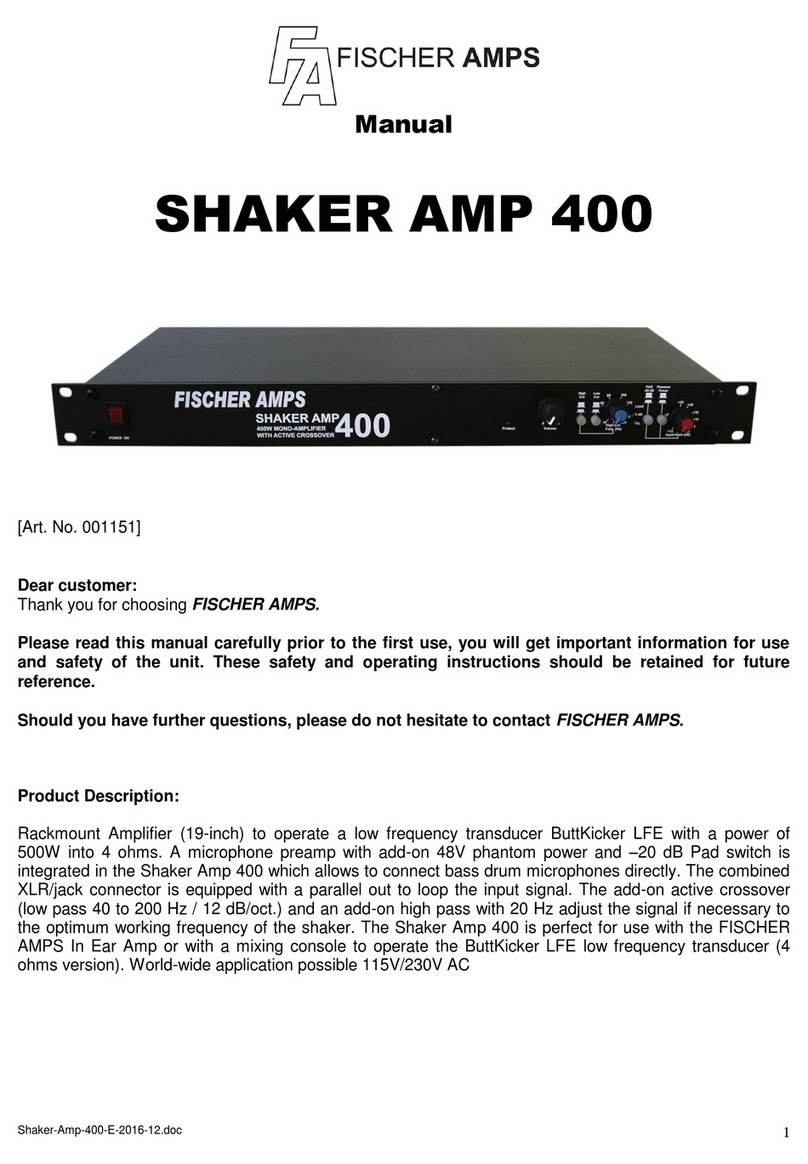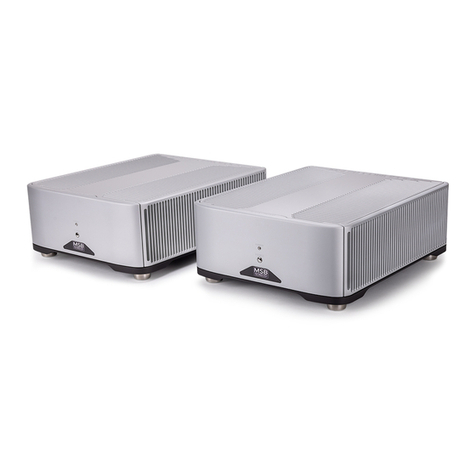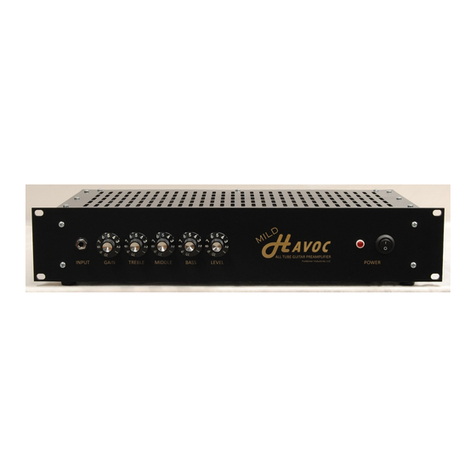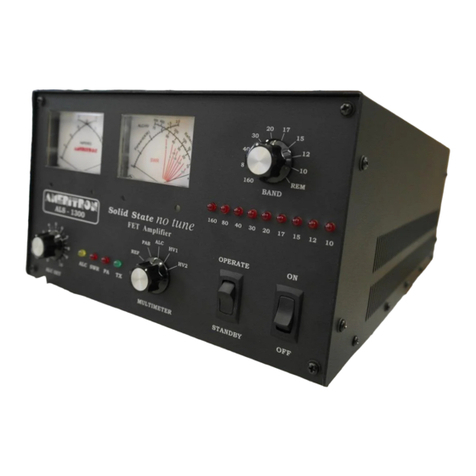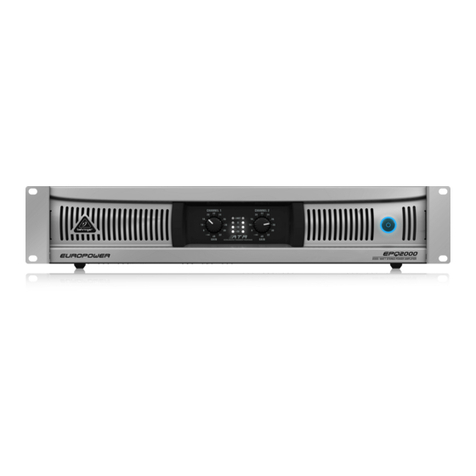Fischer Amps DRUM INEAR AMP User manual

1
FISCHER AMPS
MANUAL
DRUM INEAR AMP
Dear customer:
You have decided to buy a
Fischer Amps
product. Thank you.
Please read this manual carefully prior to the first use, you will get important in formation for
use and safety of the unit. These safety and operating instructions should be retained for
future reference.
Should you have further questions, please do not hesitate to contact FISCHER AMPS.
Product Description:
The Drum Inear Amp made by Fischer Amps has been developed for supplying In-Ear Systems of
drummers. Especially drummers need additional support in the bass sector to have the feeling for the
bass drum beat when using in-ear monitoring systems. When using a bass shaker which is mounted
to the drummer throne the bass can be perceived impressively without noise. The Drum Inear Amp
with the corresponding bass shaker is a low-cost monitoring solution for drummers with high demands.
The supplied mounting bracket for the amplifier allows direct mounting to the drum set for convenient
control.
Basic information on the use of in-ear monitor systems:
CAUTION:
Using this system at too high sound levels may cause permanent hearing defects. Adjust the volume
so that you can hear sufficiently. Ringing in the ears can indicate that the adjusted hearing level is too
high. Use headphone systems with good fitting which suppress the ambient noise well. This allows
that the required listening volume can be low which is kind to your ears.

2
Actuators front side
Description of the actuators (front side) :
(1)
Channel 1/2
Volume control: Preset of volume for channel 1 and 2
(2)
Channel 1/2
Pan (balance) control:
in stereo mode: Adjustment of the balance of volume between channel 1 and 2
channel 1 (left), channel 2 (right)
in mono-mix mode: Adjustment of the volume level ratio between channel 1 and channel
2. Channels 1 and 2 are output together to both headphones. In
middle position both channel levels are equal; at left stop only
channel 1, at right stop only channel 2.
(3)
Change-over switch channel 1/2
Stereo, mono mix mode:
Stereo mode: The device outputs the signal fed into the left input (channel 1) to the
left headphone and the signal from the right (channel 2) to the right
headphone.
Mono mix mode: Channel 1 and channel 2 are mixed and output to both headphones.
By means of the pan (balance) control, the ratio between both
channels can be adjusted.

3
(4)
Channel 3/4
Volume control: Presetting of volume for channel 3 and 4
(5)
Channel 3/4
Pan (balance) control:
in stereo mode: Adjustment of the balance of volume between channel 3 and 4
channel 3 (left), channel 4 (right)
in mono-mix mode: Adjustment of the volume level ratio between channel 3 and channel
4. Channels 3 and 4 are output mutually to both headphones. In
middle position both channel levels are equal; at left stop only
channel 3, at right stop only channel 4.
(6)
Change-over switch channel 3/4
Stereo, mono mix mode:
Stereo mode: The device outputs the signal fed into the left input (channel 3) at the
left headphone and the signal from the right (channel 4) at the right
headphone.
Mono mix mode: Channel 3 and channel 4 are mixed and output to both headphones.
By means of the pan (balance) control the ratio between both
channels can be adjusted.
(7)
LED volume level: There is one signal OK LED (green) and a clip LED (red) each for the
left and right channel. Adjust the input volume level at the preset
controllers so that the green LED lights when there are input signals.
If a red LED lights, the volume level should be reduced at the preset
controllers.
The LEDs indicate the volume levels before the master volume
controllers for the headphones output and the bass shaker.
(8)
Volume control
bass shaker output: Controller for adjusting the intensity of the bass shaker signal and the
volume level of the low-cut-line out signal.
(9)
Control Cut-off Frequency
bass shaker: Adjustment of the cut-off frequency of the bass shaker signal (low
path 12 dB/Oct.). The adjustment range is 40 Hz – 200 Hz.
(10)
Volume control
headphones output: Control for adjusting the overall headphone volume left and right.
(11)
¼" stereo jack: Connection of the headphone system (minimum impedance 16 ohms
per side.)
maximum output power 150 mW per channel
Tip = left signal, ring = right signal, sleeve = ground
IMPORTANT: The stereo jack may only be operated with a stereo headphone set with stereo jack
connector. When using a mono jack connector, the right side of the amplifier is
short-circuited permanently and is overloaded.

4
Actuators back side
Description of the actuators (back side) :
(1 / 2)
XLR inputs
channel 1 (left)
channel 2 (right): Connections of the input signal from the mixing console.
Assignment of XLR plug: 1 = Ground
2 = Signal +
3 = Signal -
With asymmetrical wiring; PIN 3 should be assigned to Ground
(bridge circuit in connecting plug).
Rated input sensitivity 0 dBu, input impedance 10kOhm
(3 / 4)
Jack ¼" inputs
channel 3 (left)
channel 4 (right): Connections of the input signal from the mixing console or another
source (CD, drum computer, sequencer)
Assignment of the sym. jack: Sleeve = Ground
Tip = Signal +
Ring = Signal -
For asymmetrical wiring, plug in a mono jack connector.
Rated input sensitivity -10dBu, input impedance 10kOhm

5
(5)
Line-In Shaker Amp Symmetric jack input for direct control of the shaker
section. The signal is provided by the active frequency crossover. This
is a useful feature to control the shaker via a separate auxiliary out of
the monitor mixing console. When using this plug, input channels 1 to 4
are not routed to the shaker section any more and thus are only present
at the headphone section.
(6)
Bass-Shaker Out Connection of the bass shaker. Max. RMS output power 75 W.
Minimum load impedance 4 Ohm.
(7)
Power switch: Activation of voltage supply of the device.
When activated, the switch lights red.
(8)
Power In jack Euro power jack with fuse holder for connecting the power cable.
Operating voltage 230V 50/60Hz.
Caution: Pay attention to connect a 3-pole cord with protective earth
conductor (PE). Do not use any damaged power cables.
Mounting the bass shaker to the drummer throne:
•Unscrew the two wring nuts at the mount of the bass shaker.
•Fix the bass shaker at the beam of the throne by means of the fastening clamp.
•Take care for tight fit, as otherwise the vibrations cannot be transmitted optimally.
Mounting the amplifier to the Hi-hat machine or to the rack of the drum set:
•Fix the part at a suitable place by means of the fasting clamp.
•Slightly unscrew the wring nut for fastening the amplifier.
•Attach amplifier and fasten it in a suitable position by means of the wring nut.
Connecting the bass shaker to the amplifier:
•Plug the 1/4" jack connector of the cable which is attached to the bass shaker into the bass shaker
Out jack at the amplifier.
Connecting the power supply of the amplifier:
Connect the amplifier to a socket with grounding contact by using the core supplied.
Caution! Only use 3-pole cores with plug with protective ground. Never use damaged cables,
exchange a damaged cable (risk of electric shock!).
Connecting the input signals channel 1 and 2:
There are 4 inputs for the input signals. These inputs for channel 1 and 2 are symmetric XLR jacks
with a rated input sensitivity of 0 dBu where for instance the auxiliary outs (monitor outputs of a mixing
console) or the left/right main mix can be connected. In stereo mode channel 1 is output left and
channel 2 is output right. If you want to press key Mono for channel 1-2 at the front side when you only
have a mono signal and want to hear the signal on both earphone sides.

6
Connecting the input signals channel 3 and 4:
Inputs for channel 3 and 4 are symmetrical jacks ¼" with a nominal input sensitivity of –10 dBu, where
you can connect additional signals (such as CD player, sequencer, click signals, etc.). Press key Mono
for channel 1-2 at the front side when you want to hear a mono signal at both sides of the earphones.
If you want to hear the click signal supplied only at the right side, plug it into the input channel 4.
If you want to hear the click signal only at the left side, plug it into the input channel 3.
There is also the possibility to connect completely different signals at channels 3 and 4 (e. g.
sequencer and click). When you want to hear these two signals at both sides of the earphones, press
key Mono for channel 3-4 at the front side. The volume ratio of the two signals can be adjusted with
the balance control of channel 3-4.
OPERATION OF THE DRUM INEAR AMP:
Adjustment of the optimum working level:
When all required connections are made and the Drum Inear Amp is switched on, make sure that the
input signals have contact with the Drum Inear Amp. Turn channel 1-2 volume control until the signal
OK LEDs light; then you have the optimum input level. When you have connected input signals at
channel 3-4 as well, also turn channel 3-4 volume control until the signal OK LEDs light. When no
signal OK LED lights at the right stop (maximum) of the volume control, increase the level of the
connected input signal at the signal source.
When the red clip LEDs light, decrease the level at the input volume controls of channel 1-2 or channel
3-4, respectively, as otherwise the limiters respond, and the dynamic range is restricted extremely.
Adjustment of the earphones/headphones volume:
Connect your earphones with the phones output jack at the front. Any headphones system with an
impedance greater or equal 16 Ohm can be connected at this jack. If your headphones system has an
1/8" stereo jack connector, use the adapter supplied with the Drum Inear Amp.
Now adjust the volume which is agreeable to you with the volume control (Phones-Out).
IMPORTANT: Only use stereo headphone systems with 3-pole jack connectors.
Adjustment of the intensity of the bass shaker:
Sit on the drummer throne and set the bass shaker's volume control to an intensity which is
convenient for you compared to the headphone volume. The characteristics of the bass signal can be
adjusted by means of the cut-off frequency control of the bass shaker output. The more you turn the
control in clockwise direction, the higher frequencies are output to the bass shaker (up to max.
200Hz). The adjustment you select can completely depend on your personal taste. Fischer Amps,
however, recommend a cut-off frequency of approx. 80 Hz.
BLOCK DIAGRAM:
(see page 7)

7

8
CAUTION:
Depending on the intensity of the bass shaker, the amplifier warms up to approx. 45
Centigrades during operation. However, this is normal as the housing is used as a heat sink for
the dissipated heat of the amplifier.
SPECIFICATIONS AMPLIFIER:
Dimensions l x w x h: 185 x 120 x 110 mm
Weight: 2.2 kg
Input connectors: 2 x Neutrik XLR-jack 3-pole
3 x jack stereo 1/4"
Output connectors: Bass-Shaker Out: 1 x 1/4" jack mono
Headphone Out: 1 x 1/4" jack stereo
Frequency response: Headphones output 30 Hz – 20 kHz +/- 2dB
Bass-Shaker 20Hz – 200 Hz (variable)
Min. load impedance
of the headphone system: 12 Ohm per side
Input impedance channel 1-4: 10 kOhm
Max. input sensitivity symmetrical: channel 1-2:+10 dBu
channel 3-4:+ 3 dBu
Max. output power connected to 20 Ohm
Headphone output : 150 mW per channel
Max. output power connected to 4 Ohm
Bass-Shaker amplifier : 75W RMS
Power supply: 230VAC 50/60 Hz
max. input power: 90W
Power fuse 0.8 AT
SPECIFICATIONS BASS-SHAKER:
Nominal impedance: 4 Ohm
Maximum power: 50 W RMS
FISCHER AMPS
Hans-Ulrich-Breymann-Str. 3, D-74706 Osterburken / Germany,
Phone +49 (0)6291–648 79-0, Fax 648 79-19
Table of contents
Other Fischer Amps Amplifier manuals
Popular Amplifier manuals by other brands

Alpine
Alpine MRD-M1000 owner's manual

Elliott Studio Arts
Elliott Studio Arts 66-100 owner's manual

Akai
Akai AM-2200 Service manual
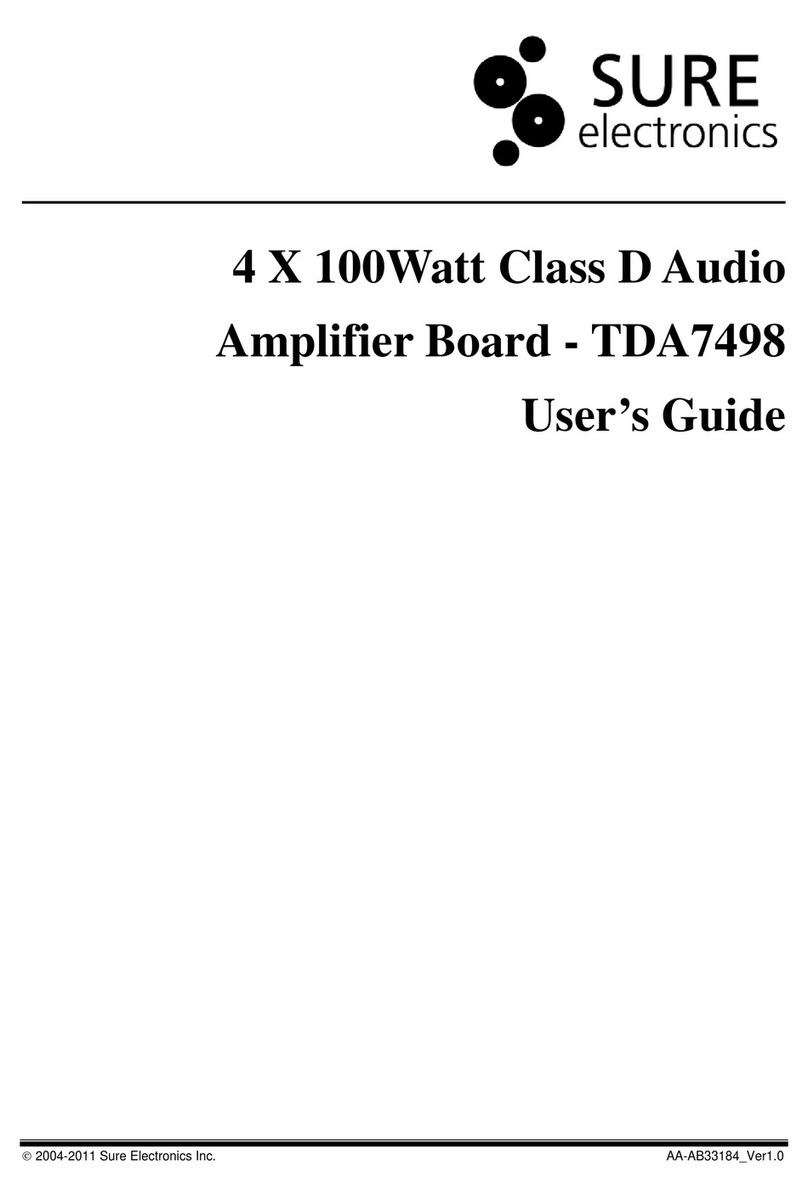
Sure Electronics
Sure Electronics TDA7498 user guide

Audio Research
Audio Research 600 owner's manual
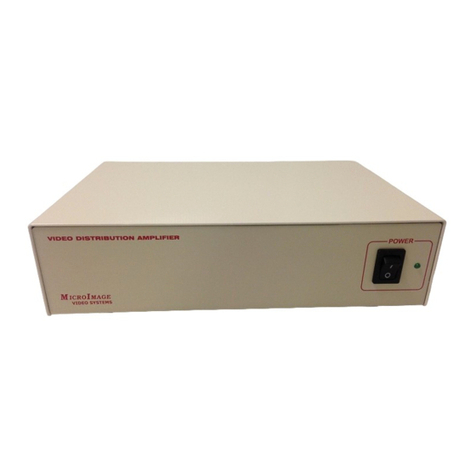
World Video Sales
World Video Sales MicroImage Video Systems VDA106 Operation manual



